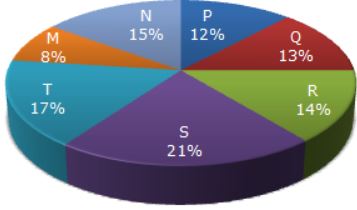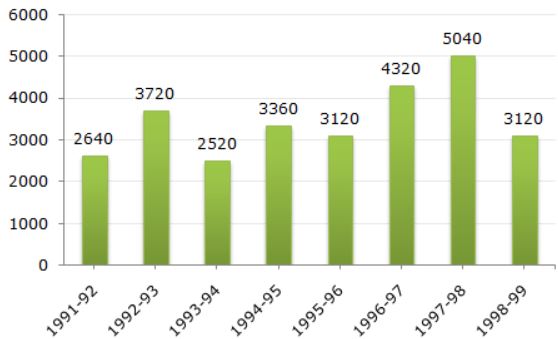 Introduction
Introduction
Data Interpretation is the ability to analyze, interpret and visualize the provided data to arrive at conclusions and to make inferences. Data Interpretation questions in the competitive exams is a test of analytical abilities. In the competitive exams, the Data Interpretation questions are grouped together and refer to the same table, graph or other data/visual presentation. The test takers are required to interpret or analyze the given data to answer the questions. In India, competitive exams related to employment in Banking, SSC, Insurance etc..have the Data Interpretation type of questions.
The article IBPS PO Data Analysis & Interpretation Quiz 3 provides Important Data Analysis & Interpretation Multiple choice questions useful to the candidates preparing IBPS PO Mains, Insurance and Bank Exams 2019.
 Quiz
Quiz
Directions (1-5): The following line graph gives the percentage of the number of candidates who qualified an examination out of the total number of candidates who appeared for the examination over a period of seven years from 1994 to 2000.
Percentage of Candidates Qualified to Appeared in an Examination Over the Years
1. The difference between the percentage of candidates qualified to appeared was maximum in which of the following pairs of years?- A. 1994 and 1995
B. 1997 and 1998
C. 1998 and 1999
D. 1999 and 2000
- A. 1995 and 1997
B. 1995 and 2000
C. 1998 and 1999
D. Data inadequate
- A. 32000
B. 28500
C. 26500
D. 25000
- A. 34700
B. 32100
C. 31500
D. Data inadequate
- A. 24500
B. 22000
C. 20500
D. 19000
Directions (1 to 5): The following pie-charts show the distribution of students of graduate and post-graduate levels in seven different institutes in a town.
Distribution of students at graduate and post-graduate levels in seven institutes:
Total Number of Students of Graduate Level = 27300
Total Number of Students of Post-Graduate Level = 24700
1. What is the total number of graduate and post-graduate level students is institute R?- A. 8320
B. 7916
C. 9116
D. 8099
- A. 14 : 19
B. 19 : 21
C. 17 : 21
D. 19 : 14
- A. 7516
B. 8463
C. 9127
D. 9404
- A. 13 : 19
B. 21 : 13
C. 13 : 8
D. 19 : 13
- A. 5601
B. 5944
C. 6669
D. 8372
Directions (1 to 5): The bar graph given below shows the foreign exchange reserves of a country (in million US $) from 1991 - 1992 to 1998 - 1999.
Foreign Exchange Reserves Of a Country. (in million US $)
1. The ratio of the number of years, in which the foreign exchange reserves are above the average reserves, to those in which the reserves are below the average reserves is?- A. 2:6
B. 3:4
C. 3:5
D. 4:4
- A. 0.7
B. 1.2
C. 1.4
D. 1.5
- A. 1992-93
B. 1993-94
C. 1994-95
D. 1996-97
- A. 95%
B. 110%
C. 115%
D. 125%
- A. 100
B. 150
C. 200
D. 620









